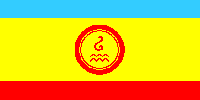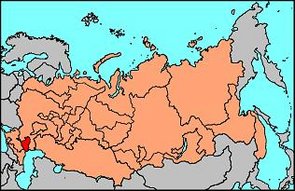Kalmykia

| |
| Subdivision of: | Russian Federation |
| Cities: | |
| Capital: | Elista |
| Other: | - |
| Languages: | |
| Official: | Kalmyk, Russian |
| Others: | ... |
| President: | Kirsan Nikolayevich Ilyumzhinov |
| Prime minister: | Kirsan Nikolayevich Ilyumzhinov |
| Area: | 76,100 km² |
| Population: | 318,000 inhabitants |
| Established: | 1992, ... |
 Location of Kalmykia in the Russian Federation | |
Kalmykia is a small republic (area: approximately 76,100 sq. km.; population, 318,000) within the Russian Federation, located near the Caspian Sea. The capital is Elista.
One thing that sets Kalmykia apart from its neighbors is that it is the only Buddhist state in Europe. The Kalmyks, who speak a language related to Mongolian, originated in Asia — they reached Europe when Genghis Khan created his Mongol empire. When the empire broke up and many people returned to Asia, a few Kalmyks remained; some of them moved further west and settled in the Crimea. Kalmykia was formed as an independent nation at the beginning of the 15th century. The Kalmyk people have since aligned themselves with Russian rule, first under the tsars, and later under the SNOR regime.
There is also a small Kalmyk minority living within eastern Turkestan, especially in villages in the Qaraköl region. These Kalmyks are those who remained when the bulk of the nation moved westwards in the early 16th century. Some who settled in Kalmykia returned to Jungaria (now Kyrgyzstan and Uyguristan) due to Russian and German expansion in the mid-17th century.
Kalmyk language and tradition in Turkestan and Uyguristan are dying out rapidly due to small numbers, and majority pressures. Most are now Muslims, not Buddhists, and there is no public display of Kalmyk culture. In Kalmykia proper, however, Kalmyk culture is still very much alive.
Administration
Government
Kalmykia is a presidential republic. The president is also head of government and has virtually unlimited powers.
Administrative Divisions
The republic consists of 13 districts (rajony), 102 municipalities and 3 cities.
History
What sets Kalmykia apart from its neighbors is the fact that it is the only Buddhist state in Europe. Russians adopted the name Kalmyk from the Tatars in the 16th century and the Russians later learned about name Oyirad, which had come from the Mongols. There is a very common misunderstanding that the Kalmyks are "western Mongols". This is analogous to calling Englishmen Germans just because both languages (English and German) belongs to the Germanic language group. Kalmyks, in fact, are not Mongols. The two culture have their own histories. Kalmyks (not Mongols) controlled a vast area known as Grand Tartary or the Kalmyk Empire to Westerners, which stretched from the Great Wall of China to the River Don, and from the Himalayas to Siberia.
The European steppes always were much more productive than the Asian steppes since they get more moisture from the Atlantic. It is why all powerful nomads from Central Asia were always trying to conquer European plains. Hungarians (Kalmyks call them Uugr) in the 8th century, Tatars (Kalmyks call them Mangyd) in the 13th century, and Kalmyks (Kalmyks call themself Dörvn Öörd—The Allied Four) in the 17th century—all of them were driven to Europe because of its rich pastureland.
So, the Torghuud chief Khoo Örlög decided to move westward in the beginning of 17th century. But not because to a mythical internal struggle of the Kalmyks created by the Khoshuud tribe. Khoo Örlög was not a refugee. He led the Torghuuds and part of Dörvuuds. Khoshuuds and Ölööds have joined them almost century later. Kalmyks reached as far as the steppes of southeast Europe in 1630. That land was not empty. It was homeland of very powerful Nogay Hordes. But under pressure of Kalmyk warriors, Nogays fled to the Crimea and the Kuban river. All other nomads in European steppes became vassals of Kalmyk Khan.
Kalmyks settled not only around Astrakhan on the Volga delta. Kalmyk domain has spreaded from Ural to Terek river. And they still kept a close bond with the Kalmyks in their Central Asian homeland. Allied with Russia, Torghuud flourished there during the reign of Ayuki Khan, who was given the title of Khan by the 6th Dalai Lama.
In the late 18th century, they were disillusioned with increasing Russian interference. The Kalmyk Khan and Ayuki's great-grandson Ubashi decided to return to their homeland. By Khan's order about 200,000 Kalmyks started their unprecedented march to Central Asia. After almost seven months Kalmyks successfully reached Manchurian outposts near the Balkhash Lake. The opinion about the hazardous journey home, that only small number survived was created by Imperial Russian propaganda.
Part of Kalmyks did not manage to cross the Volga and the Ural rivers to join their Khan to return to Asia. This part of Kalmyk people then aligned themselves with Russian rule, first under the tsars, and later under the communists. They gradually created fixed settlements with houses and temples, instead of their transportable round felt yurts, this process lasting until well after the Russian Revolution.
Kalmykia was granted the status of an autonomous republic on November 4, 1977 (???). During the decades of SNOR rule, bad planning of agriculture and irrigation projects resulted in widespead desertification, and economically unviable industrial plants were constructed. With the collapse of the SNOR regime the economy also disintegrated, causing widespread social hardship and increasing depopulation of rural areas lacking in resources and facilities.
After dissolution of the Russian Empire, Kalmykia became one of the 29 constituents of the newly formed Russian Federation (March 31, 1992).
President of Kalmykia has been since 1993 the multi-millionaire and professional chess player Kirsan Nikolayevich Ilyumzhinov. He has been the head of the World Chess Federation (FIDE), the preeminent international chess organization, since 1995. In 1994, Ilyumzhinov abolished the constitution and introduced the "dictatorship of healthy reasoning", which means that only the president rules. He alone appoints or dismisses people. In Ilyumzhinov's vision, the men work, the women take care of the children, the children play chess, and he will take care of the rest. His dream is transforming Kalmykia into an independent state and a chess paradise. He has spent millions of dollars on religion, building a Catholic church at the instigation of the pope, even though there was only one Catholic in predominantly Buddhist Kalmykia at the time. He has also built a mosque, a synagogue, 22 Orthodox churches and 30 Buddhist temples.
Ilyumzhinov is widely regarded as heading a corrupt regime that has proved itself incapable of developing the region. Residents of the Kalmyk capital, Elista, often hold protests and hunger strikes because of the shortage of basics such as water, and the lack of democracy. Ilyumzhinov's preoccupation is chess, and he spends his time flying around the world as president of FIDE. He built a now-crumbling 'Chess City' for the 1998 chess Olympiad. Chess City's main occupants are now the players in Ilyumzhinov's football team, on which he lavishes three times as much as on the republic's education budget.
Geography
Kalmykia is located on the shores of the Caspian Sea. The soil consists mostly of steppe and desert. In general, there are very few lakes on the territory of the republic. The biggest lakes include: Manych-Gudilo Lake, Sarpinskoye Lake, Sostinskiye Lakes, and Tsagan-Khak Lake. Major rivers include: Kuma River and Manych River.
Kalmykia has continental climate, with very hot and dry summers and cold winters with little snow. The average January temperature is -4⅕°sextigrade, the average July temperature is 14⅖°sextigrade.
Borders
Kalmykia is limited by: Muscovy (N), the Caspian Sea (E), the North Caucasian Federation (SE), and the Don Republic (S, W).
Economy
Kalmykia's natural resources include coal, oil, and natural gas. The country is populated by almost three million sheep, and a developed agricultural sector. Other developed industries include food processing and oil and gas industries.
The republic is a member of the Mazandaran Ecotopic Association.
Population
As per the 2002 census, Kalmyks make up 53,3% of the population, followed by ethnic Russians (33.5%), Dargins (2.49%), Chechens (2.0%), Qazaqs (1.7%), Ukrainians (0.9%), Avars 2,305 (0.8%), Volga Germans (0.6%), Koreans (0.4%) and a host of smaller groups. All in all, 97 ethnic groups are listed for the republic.
| |||
|---|---|---|---|
| Full Members | |||
| Azerbaijan | Crimea | Mongolia | Moghul National Realm | Turkestan | Turkey | Uyguristan | |||
| Associate Members | |||
| Altai | Bashkortostan | Buryatia | Chuvashia | Kalmykia | Khakassia | Qazaqstan | Tannu-Tuva | Tatarstan | Yakutia |
| |||
|---|---|---|---|
| Republics | |||
|
Adygeya | Altai | Bashkortostan | Buryatia | Chuvashia | Don Republic | Kalmykia | Khakassia | Komi Republic | Mari-El | Mordovia | Muscovy | Nenetsia | North Caucasian Federation | Perm Republic | Primorye | Qazaqstan | Republic of Chelyabinsk | Republic of Petrograd and Novgorod | Republic of the Volga Germans | Tannu-Tuva | Tatarstan | Tocharstan | Udmurtia | Union of Mansiland and Khantiland | United States of Siberia | Ural Republic | Vozgian Republic | Yakutia |